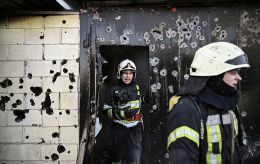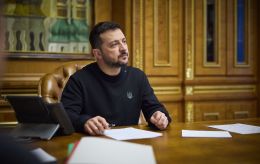Focus on Crimea and new impetus in the South - Ukraine's counteroffensive progress
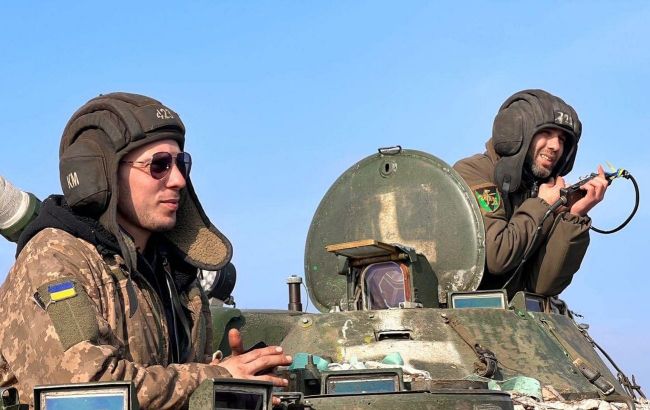 Ukrainian military forces have been advancing for nearly two months in the southern and eastern regions (photo: facebook.com/easternforce)
Ukrainian military forces have been advancing for nearly two months in the southern and eastern regions (photo: facebook.com/easternforce)
Ukrainian Armed Forces' counteroffensive has intensified in the south, with a particular focus on striking Russian positions in Crimea, making this direction a top priority. The current situation and its potential impact on the liberation of Bakhmut and the possibility of swift advances toward Berdiansk are analyzed in the overview by RBC-Ukraine.
Nearly two months have passed since the start of the counteroffensive, and lately, there's been an impression that it has slowed down. Until last week, the latest notable success was dated back to June 29th, with the liberation of the village of Rivnopil, Donetsk region.
Subsequent battles primarily occurred on the approaches to key first-line Russian defense positions, leading to concerns about the Ukrainian forces' progress on the Western front. Defense Minister Oleksii Reznikov acknowledged that the advance is slow but corresponds with the plan. However, several factors work against them, including the quantity of ammunition, anti-aircraft defense systems, and the length of the front line.
In an interview with CNN, Reznikov emphasized that the situation is challenging, with a long frontline and numerous enemies to contend with. He stressed that it is a real war, not a computer game and that Ukrainian forces have to manually clear minefields.
Following this, Bloomberg and The New York Times reported on the commencement of a major offensive in the south, with unnamed sources at the Pentagon suggesting that the main thrust is expected to be south of Orikhiv, Zaporizhzhia region toward the occupied city of Melitopol.
Clearly, the focus at present lies on the southern direction, despite the simultaneous advancement of the Ukrainian forces toward Bakhmut and successfully repelling the Russian attempt to break into the Kharkiv region from the direction of Svatove.
Lyman-Kupiansk direction: A failed breakthrough attempt
Last week, Russian and Ukrainian Telegram channels reported the seizure of three small villages in the Luhansk region – Nadiia, Serhiivka, and Novoiehorivka. However, the spokesperson for the Operational Command East of the Ukrainian Armed Forces, Serhii Cherevatyi, refuted this information, stating that there were no significant changes in the tactical situation in that area.
The analysts at the DeepState portal clarified that the situation in this region was dynamic, with Russian forces attempting to advance, but the Ukrainian Defense Forces received reinforcements and stabilized the front line.
According to the current map, Nadiia remains under Ukrainian control, Novoiehorivka is in the gray zone, and Serhiivka has been entered by enemy troops.
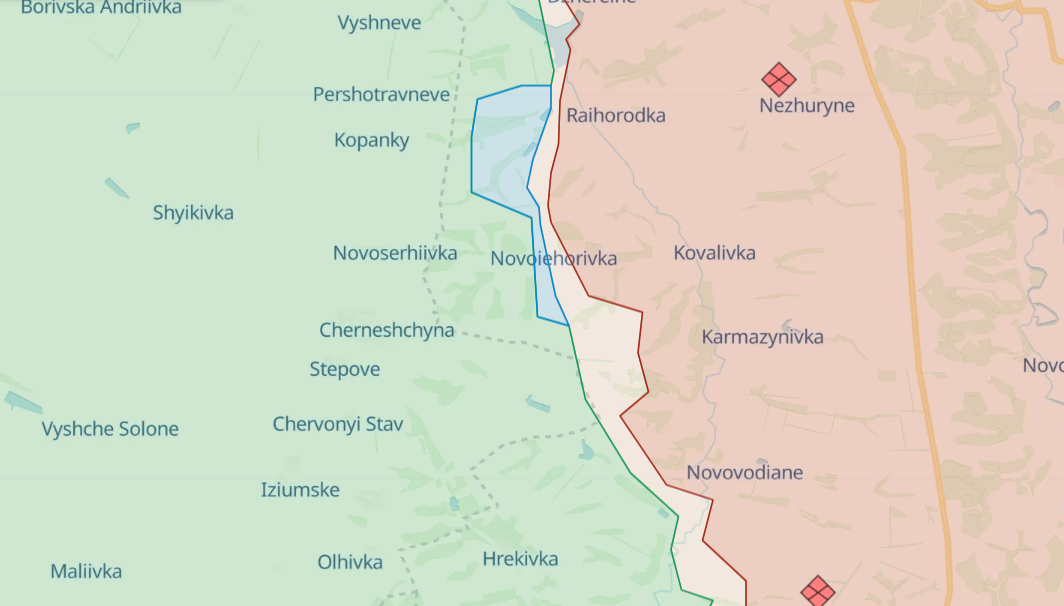 Ukrainian forces have stabilized the frontline along the Svatove-Borova line (Photo: deepstatemap.live)
Ukrainian forces have stabilized the frontline along the Svatove-Borova line (Photo: deepstatemap.live)
The Head of the Сenter of Military Law Researches, Oleksandr Musiienko, points out that sometimes the Russians manage to achieve tactical success, but our forces consistently repel their advances.
"The enemy attempts to operate in small forests, in the so-called "greenery," and occasionally employs artillery and tanks. However, speaking globally about the Lyman-Kupiansk direction, Russia has achieved nothing at all. Its troops have not reached Borova (Kharkiv region - ed.), have not breached our defense, nor occupied the left bank of the Oskil River, and they have not managed to attack our positions in the area of Bilohorivka and Bakhmut from the northern flank," he explained in a comment to RBC-Ukraine.
As reported by NYT, it is not excluded that the Russian offensives toward Borova, Kupiansk, and Lyman are related to the advancement of the Defense Forces further south. The publication believes that if the Ukrainian forces hold their positions and, for instance, launch an attack toward Kreminna, they could disrupt the logistics of the adversary and even encircle Bakhmut from the rear.
Bakhmut direction: The Russians suffer heavy losses
Ukrainian forces are making slow but steady progress in this direction. Recently, President Volodymyr Zelenskyy visited Bakhmut to greet the Special Operations Forces soldiers. With their involvement, they are actively pushing the Russians out of positions near the villages of Klishchiivka, Andriivka, and Kurdiumivka on the southern flank. According to some reports, battles are now taking place on the streets of these settlements.
Serhii Cherevatyi emphasizes that the counteroffensive here is continually gaining momentum, and they are advancing several hundred meters daily.
"It's a tactic of slow but steady advancement. We understand that we might be outnumbered in terms of forces and resources, but sometimes the enemy surpasses us in numbers," he noted.
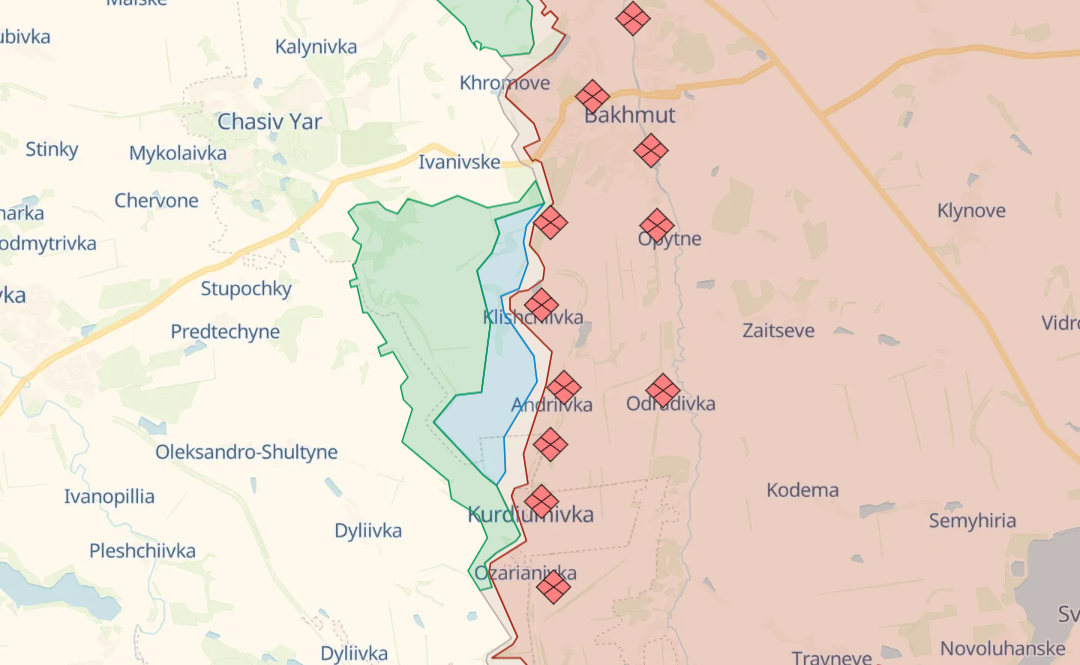
Defense forces continue to push the Russians south of Bakhmut (photo: deepstatemap.live)
According to him, Ukrainian forces near Bakhmut employ tactics of encirclement, maneuvers, and ambushes, rather than direct frontal attacks, unlike the notorious Russian "meat waves." He further points out that enemy losses only on the Bakhmut stretch have exceeded the casualties the USSR suffered throughout the ten-year Afghan campaign (15,000 fatalities).
Commander of Ground Forces, Oleksandr Syrskii, stresses that the enemy here is constantly targeted by artillery. He published a relevant video with a caption indicating that the movement continues.
According to military expert Oleksii Hetman, there are reasons why the Southern offensive is more active than the Northern one.
"Most likely, the Russians have a stronger defense on the north and have concentrated more troops there. For us, this doesn't change the task, which is to encircle the city. It's not necessary to surround it from all sides immediately; we can strike from the south, drive out the enemy from Bakhmut, and then move further to the north," he explained in an interview with the RBC-Ukraine.
Oleksandr Musiienko believes that the offensive toward Bakhmut could have been more rapid if the Defense Forces had sufficient artillery and other resources.
"In that case, I believe our units would have already liberated Bakhmut. But it's evident that, from the perspective of the counteroffensive, the priority is the South. Hence, the troops around the Bakhmut area are accomplishing a phenomenal task, achieving success," he added.
Berdyansk direction: What's next after Staromaiorske
After a month of fighting, on July 27th, it became known that the village of Staromaiorske (Volnovakha district, Donetsk region) was liberated. Since the de-occupation of Rivnopil, this was the first similar success of the Armed Forces of Ukraine.
According to Valerii Shershen, the spokesperson for the Tavria direction, the battle for the village was prolonged due to moving under conditions of total minefields. Therefore, the operation can be considered somewhat unique.
"When our assault troops advanced to the center of Staromaiorske, toward the southern outskirts, they encountered total mining. The Russians mined everything they could, even our guys from Special Operations Forces were stunned. Our engineers had a lot of work, and the sappers used various tricks to clear the area," he revealed.
Therefore, the assault troops advanced with special equipment, removing and detonating the tripwires. However, they couldn't take out captured enemy equipment due to the presence of "mine gates" (wide and deep obstacles). Additionally, the situation was complicated by bad weather, as heavy rains washed away dirt roads.
According to DeepState maps, they managed to advance several kilometers toward the occupied village of Volodyne. Some analysts point out that, after Staromaiorske, the Ukrainian forces will face the second line of defense of the Russian Federation.
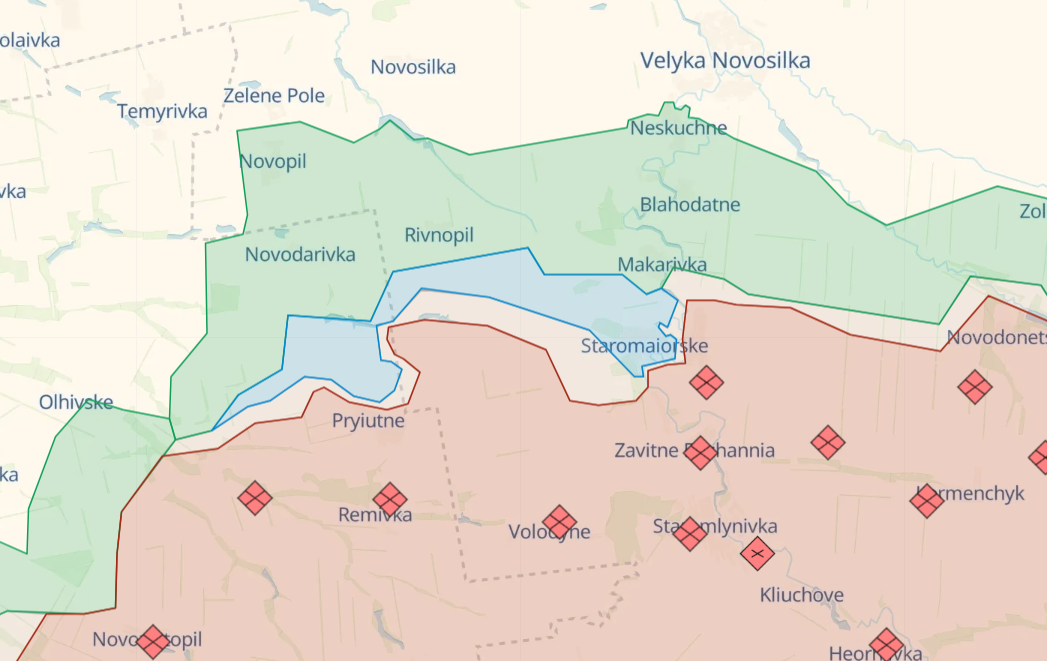 Behind Staromaiorske village, most likely, the second line of defense of the Russian Federation is deployed (photo from deepstatemap.live).
Behind Staromaiorske village, most likely, the second line of defense of the Russian Federation is deployed (photo from deepstatemap.live).
"Now the task is to consolidate on new frontlines and create opportunities for further advancement toward Zavitne Bazhannia, Urozhaine, and Staromlynivka. The latter is a crucial elevation that allows our artillery to strike the Russians further south. There are challenges related to mines and constant enemy counterattacks. So, expecting a rapid advance is not advisable," says Oleksandr Musiienko.
Expert Oleksii Hetman draws attention to the fact that the American Institute for the Study of War (ISW) and Western intelligence lean toward the idea that the Ukrainian forces may need up to three weeks to reach the shores of the Azov Sea or at least secure a land corridor to Crimea under fire control.
Melitopol direction: Way to Tokmak
Another direction where the Ukrainian Armed Forces demonstrate success is the area around Mala Tokmachka-Robotyne, as mentioned by Deputy Minister of Defense Hanna Maliar in her Telegram message.
"On the Mala Tokmachka-Robotyne direction, there has been a success, and they are holding their positions at the achieved frontlines," she wrote.
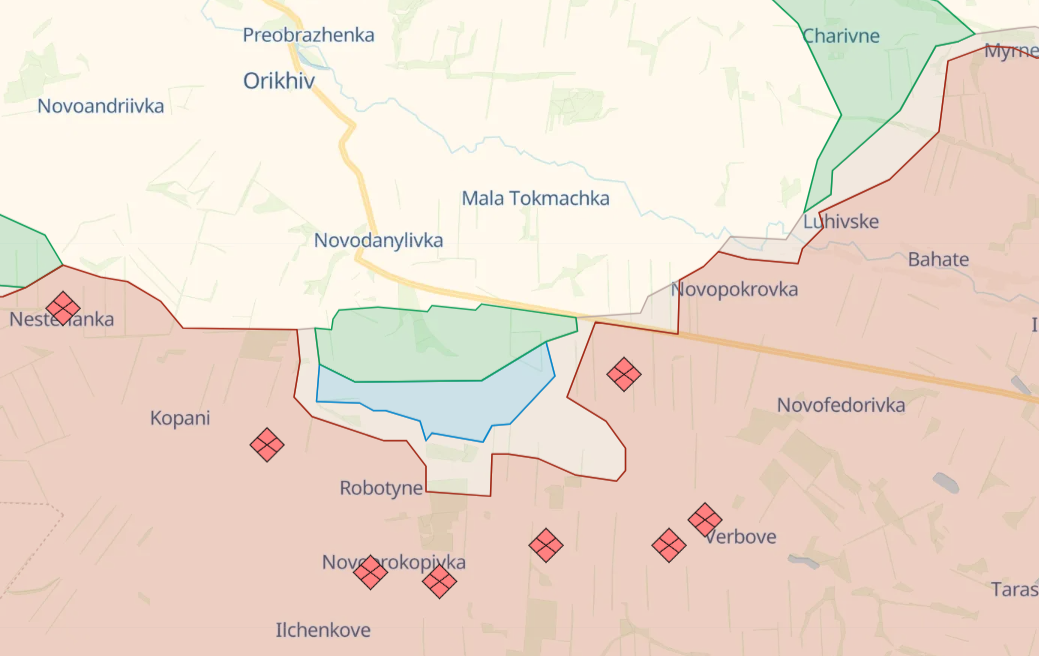 The Ukrainian Armed Forces hold positions near Robotyne in the Zaporizhzhia region (photo deepstatemap.live)
The Ukrainian Armed Forces hold positions near Robotyne in the Zaporizhzhia region (photo deepstatemap.live)
Moreover, Western media do not rule out the possibility that Ukrainian forces could have advanced close to the so-called "Dragon's Teeth" (concrete anti-tank pyramids) near the occupied Tokmak. In particular, a video has been circulating online showing Ukrainian military vehicles attempting to cross a river east of the villages of Nove and Kharkove. According to the map, this location is quite far from the usual Ukrainian positions.
Satellite imagery indicates that the "Dragon's Teeth" are spread in three rows almost along the entire front line. It is quite possible that the Ukrainian military is indeed searching for weak spots in the enemy's defense near Tokmak.
"They have two tasks - demining the territories and identifying vulnerabilities for further advances. The intelligence near the "Dragon's Teeth" is all about that. However, our forces are currently focused on consolidating on new frontlines," says Musiienko.
Overall, according to British intelligence, it is quite probable that the southern advance has exhausted two Russian armies - the 58th south of Orikhiv and the 5th in the area of Velyka Novosilka. They also believe that the Russian forces will soon face a significant problem of shortages in reserves and ammunition for artillery.
Strikes at the rear: Moscow and Crimea
Over the past few days, the fourth and fifth drone attacks on Moscow have taken place. In both cases, the strikes hit the business district Moscow City in the center of the Russian capital.
Initially, two drones damaged facades and partially destroyed interiors in the towers, some of which house offices of three ministries. Then, on the night of August 1, at least one drone also struck the Moscow City tower.
The Ukrainian side did not confirm involvement, but President Volodymyr Zelenskyy implied that the war is returning to Russian territory, which he considers an inevitable process.
According to the New York Times, the strikes on Moscow, in any case, diminish its ability to wage war against Ukraine. Western analysts are confident that these attacks have not only symbolic but strategic significance.
"They might force Russian military planners to make tough decisions on how to deploy resources and inflame deep divisions within the Russian leadership," the media states.
Although strikes on the bridges between occupied Crimea and mainland Ukraine could have an even greater impact on Russia's ability to wage war. Recently, the Chonhar Bridge was attacked again, this time the railway bridge.
According to Kherson self-proclaimed "governor" Vladimir Saldo, 12 Storm Shadow missiles allegedly targeted the bridge over the Syvash, and all of them were intercepted. However, images of the damaged railway tell a different story.
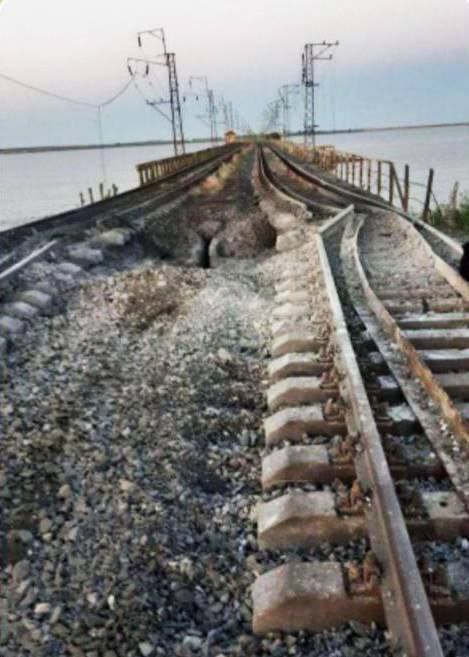
The strike on the Chonhar Bridge damaged the railway (photo t.me Bratchuk_Sergey)
Natalia Humeniuk, Head of the United Coordinating Press Center of Security and Defense Forces of the South of Ukraine, calls this a precise job that will force the Russians to seek alternative logistic routes.
Experts interviewed by RBC-Ukraine agree that the damages may not be critical, and the Russians will likely repair the railway. The main question is how much time it will take.
Oleksii Hetman emphasizes that damage to the second Chonhar Bridge could practically paralyze the land corridor.
"Effectively, it's already difficult to transport anything to Crimea, with only the Crimean Bridge remaining. However, I have a feeling that in the coming days, even that railway connection will be destroyed," he noted in a conversation with RBC-Ukraine.
According to him, once that happens, Crimea will become an island, as the Russians will be left with only air or sea logistics.
"But these will be much more significant than the case with the railway. Therefore, I believe that the southern Russian group understands that their time is running out. Soon, they'll have three options: run while they can, wait and surrender as prisoners, or, if they resist, our Armed Forces will simply annihilate them," added the expert.
Regarding the southern advance, it appears that the Ukrainian command is particularly focused on Crimea. Apart from targeting bridges, explosions are happening almost daily, and unknown drones are attacking Russian military objects and ships in the Black Sea Fleet.
Meanwhile, for the eighth consecutive week, the Ukrainian Ministry of Defense reports on liberated territories. According to the latest data, during the summer counteroffensive, over 240 square kilometers of Ukrainian land have been de-occupied. For comparison, this is slightly smaller than the area of Mykolaiv.
